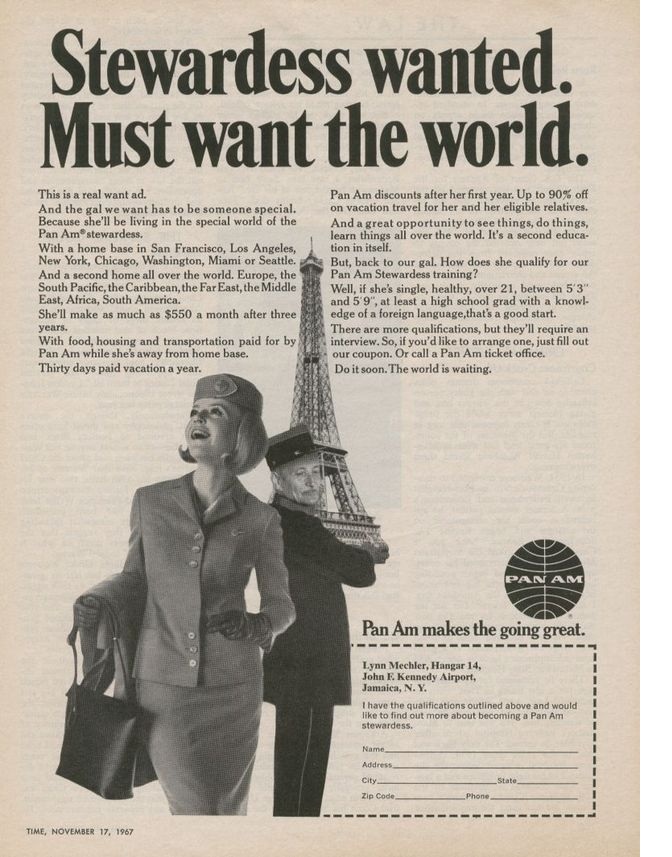A Reader’s Guide to ‘The Accidental Spy’
The Annotated “Accidental Spy”
I grew up in a Pan American family. If you lived in Miami Springs, Florida in the 1950s or 1960s, it was not a matter of whether or not yours was an airline family; only a question of it being a Pan Am, Delta, Eastern or National one. Today, the concept of a community being so tightly aligned with companies in a single industry – and especially the airline business – is quaint. Though it is a time near enough to be remembered by those over sixty, our world has changed in many fundamental ways.
In writing The Accidental Spy, I sought to accurately re-create the world of 1967. But in doing so, I did not want to bog down the story with tedious explanations of people, places or events. I wanted a novel that, to the reader, was a contemporary tale. But neither did I want to throw younger readers overboard or have them reading with a search engine in constant use. My compromise is this reader’s guide.
The story uses a ‘framing device’ – the opening and closing chapters that are set in the present – to let you know that someone is going to die in the course of this story. Someone important enough to have kept Susan Delaney in that house for more than four decades.
The framing device also allows Susan some latitude to tell in her own words about the world into which she came of age: for example, the very true statistic that, in 1961, the average age at which women married was nineteen. Or that when Susan graduated from college she confronted a job market that segregated employment into ‘Help Wanted – Male’ (with all the good, professional jobs) and ‘Help Wanted – Female’ (secretaries and department store clerks).
The Accidental Spy covers areas of recent history that probably aren’t part of any 21st Century school curriculum. Those subjects include the dawn of the microelectronics industry, the Cold War, the Six-Day War of June 1967 and attendant U.S.-Israeli relations, and the airline industry. I’ve also provided what I hope are helpful notes on cultural phenomena that might otherwise leave younger readers baffled.
Before we get started, a few words about Susan Delaney’s home on Purdy Avenue. Miami Beach residents (or those with Google or Bing Maps) will see that there are, in fact twin towers in the 1900 block of Purdy Avenue. I haven’t the faintest idea of whether bayfront single-family houses stood on the site beforehand. This is a work on fiction and I am allowed some leeway.
Now, to the story:
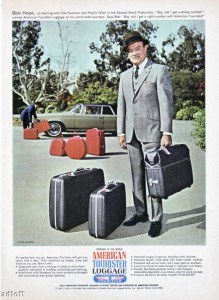 Page 8. Next to Bob Hope’s right foot in the photo on the right is the American Tourister suitcase Susan would have been carrying.
Page 8. Next to Bob Hope’s right foot in the photo on the right is the American Tourister suitcase Susan would have been carrying.
Page 8. Juan Trippe (1899-1981) founded Pan Am in the 1920s and was its CEO until early 1968. The ‘WorldPort’ was Pan Am’s terminal at JFK.
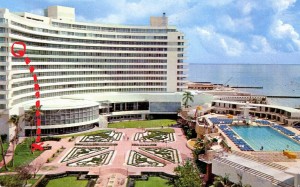 Page 10. As detailed throughout the book, stewardess uniforms became a status symbol in the 1960s. In July 1967, National Airlines had indeed not updated their uniforms since 1964.
Page 10. As detailed throughout the book, stewardess uniforms became a status symbol in the 1960s. In July 1967, National Airlines had indeed not updated their uniforms since 1964.
Page 11. The Fontainebleu Hotel today has morphed into something unrecognizable from 1967, when the hotel would have been just 12 years old. Here’s a circa-1967 photo, complete with a trajectory from room 712.
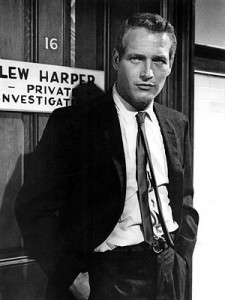 Page 12. Below, left, is Paul Newman, slouching, as Harper in the 1966 film.
Page 12. Below, left, is Paul Newman, slouching, as Harper in the 1966 film.
Page 18. The Six-Day War was fought between June 6 and June 11. The Accidental Spy takes places in mid-July’ five weeks after the cessation of hostilities, but the war and its aftermath was still very much in the news and on people’s minds.
Page 19. The first Computer Science degree in the United States was awarded in 1962 by Purdue University. By 1967, Computer Science was an established course of study in major universities. I have had readers question whether such degrees would have existed in 1967. They did.
Page 23. In 1967, Coconut Grove was the ‘bohemian’ section of Miami. The Northeast Grove, defined by S.W. 22 and 27 Avenue and south of S.W. 28 St. consisted largely of inexpensive small houses interspersed with a handful of larger, pre-1926 hurricane ones. S.W. Tigertail Court meets the description of the location described by Susan. The area is now occupied by very large, modern homes.
Page 29. Fairchild Semiconductor’s Micromosaic was introduced in May 1967 and was, at the time, the most advanced integrated circuit of its kind (it is described more fully on page 31). Coincidentally, it was the first chip developed using computer-aided-design tools.![Coffee, Tea or Me 1967 book[2][1]](http://www.thehardingtonpress.com/wp-content/uploads/2012/04/Coffee-Tea-or-Me-1967-book21-199x300.png)
Page 34. Coffee Tea or Me, the Uninhibited Memoirs of Two Airline Stewardesses appeared in April 1967. Ostensibly by “Trudy Baker and Rachel Jones”, the book was penned by adman Don Bain. It spawned a host of imitators, all of which portrayed stewardesses as obsessed with sex.
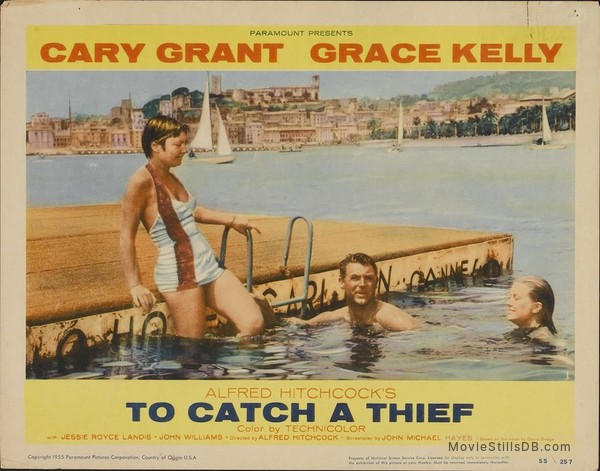 Page 35. To fully understand Susan’s To Catch a Thief reference, go rent the movie and look for the scene pictured at left. That’s Brigitte Auber in the red and white suit.
Page 35. To fully understand Susan’s To Catch a Thief reference, go rent the movie and look for the scene pictured at left. That’s Brigitte Auber in the red and white suit.
Page 36. Candlestick Park was opened in 1960 and, almost from opening day, was criticized for its dew, wind and dampness. The Giants moved out in 2004.
Pages 41-42. It went through multiple names in a short period of time but, in July 1967, the drugstore-turned-café where Susan is observing the passing parade was called the Drogstore Café. Today the building at 1398 Haight Street is the Magnolia Pub and Brewery. The groups, venues and play dates are all, to the best of my research skills, accurate. If Susan didn’t recognize groups like Big Brother and the Holding Company, it is because they were still at least a year away from achieving commercial success.
Page 44. Terry LeBlanc is a fictional character and not modeled on any single individual.
Page 47. By 1967, the development of a microprocessor (more commonly called a ‘computer on a chip’) was considered the Holy Grail of the electrical engineering community and it was assumed (especially in popular magazines) that it was simply a matter of clever engineering. Semiconductor engineers knew the enormity of the task, which involved not just designing such a chip but also building (fabricating) it. They also understood the huge payoff for the company that got there first.
Page 49. Susan’s depiction of the outcome of the Six-Day War is not far off the mark. It was a rout. Booking bar mitzvahs into the Cairo Hilton, though, was hyperbole.
Pages 50-51. In 1967, it was unclear who was winning the cold war. The Central Intelligence Agency had, for years, offered information about Soviet intentions that turned out to be flawed and the Soviet Union appeared to have developed an uncanny knack for knowing what the U.S. was about to do. Mistrust of both the CIA and FBI was rampant.
Pages 55-56. In 1967, Mary Wells (1928 – ) was a principal of Wells Rich Greene, an ad agency noted for its creativity and humor. In November 1967 she would marry Braniff President Harding Lawrence.
Pages 66-67. Yorktown Heights is still IBM’s principal U.S. advanced R&D facility. As an aside, it was here that IBM scientists devised ‘Watson’, the computer that beat the best human Jeopardy champions.
Page 69. Twelve microns (about one tenth of the diameter of a human hair) was the standard technology in 1967; ten micron technology was in fact being tested. By way of contrast, in 2012, integrated circuit manufacturing is pushing down toward lines that are just a few atoms wide.
Page 78. In 2012, the standard silicon wafer size is 300mm, or about the size of a dinner plate. The notion that wafers were once fabricated with diameters of two or three inches is incomprehensible to anyone who has come to the industry since, say, 1975.
Page 80. On June 8, 1967, during the Six-Day War, the USS Liberty, an intelligence-gathering ship positioned off the Egypt coast, was attacked by Israeli jet and torpedo boats, killing 34 and wounding 171 U.S. sailors. Israel apologized and paid compensation for the incident.
Page 86. Until the 1970s, Washington had a thriving shopping district along F Street, including a Woodward & Lothrop, Hecht’s and Garfinkel’s.
Page 99. Alpha 66 is a real organization and Andrés Nazario Sargén (1916-2004) was its leader. Its anti-Castro activities are as described here; Jorge Ruiz, however, is a fictional character.
Page 102. The Regency Hyatt House, now the Hyatt Regency Atlanta, opened in June 1967. The original hotel consisted only of the rooms around the interior atrium and the lone criticisms of the hotel were its utilitarian room decor and a drab tunnel that connected the atrium to the hotel’s entrance (long since remodeled). The round tower extension was not added until 1971.
Pages 104-105. The United States did not establish diplomatic relations with East Germany until 1974. The two countries did send trade missions back and forth as well as some cultural exchanges beginning in the mid-1960s. The ambivalent relationship between East Germany and the Soviet Union is reasonably accurate.
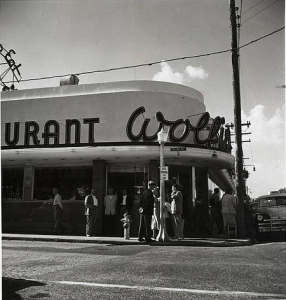 Page 106. This is the first of many references to Wolfie’s, a restaurant which once upon a time had multiple locations on Miami Beach including ones on Collins Avenue (pictured at left) and Lincoln Road. The last location closed in 2004, a victim of changing demographics and rising real estate prices. Its passing is mourned.
Page 106. This is the first of many references to Wolfie’s, a restaurant which once upon a time had multiple locations on Miami Beach including ones on Collins Avenue (pictured at left) and Lincoln Road. The last location closed in 2004, a victim of changing demographics and rising real estate prices. Its passing is mourned.
Page 109. The ‘selling’ of skilled East Germans to West Germany to get ‘hard’ (convertible) currency went on for decades until the collapse of East Germany.
Pages 120 – 123. Sadie is a fictional character but what I call ‘Sadie’s Story’ could easily be the biography of thousands of women. Feel free to type any of the names cited into a search engine (Mauthausen-Gusen; Foehrenwald; Ashdod; Operations Hiram, Ayin, or Dekel) for a glimpse of Jewish history between 1940 and 1950.
Page 123. Meir Amit (1921-2009) was head of Mossad from 1963 to 1968.
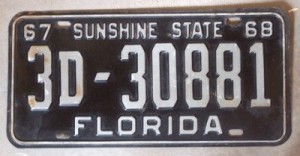 Page 128. Florida used the license plate numbering system described from the 1930s until 1977. It reportedly went out of use only because the county population figures used to determine plate headers – frozen since the program’s inception – was completely out of whack with the numbering system after more than 40 years and upstate legislators refused to accept numerical ‘demotions’ for their counties. The license plate shown at right would likely have adorned a Volkswagen (the ‘D’ designation) from Tampa (Hillsborough County, the ‘3’ designation).
Page 128. Florida used the license plate numbering system described from the 1930s until 1977. It reportedly went out of use only because the county population figures used to determine plate headers – frozen since the program’s inception – was completely out of whack with the numbering system after more than 40 years and upstate legislators refused to accept numerical ‘demotions’ for their counties. The license plate shown at right would likely have adorned a Volkswagen (the ‘D’ designation) from Tampa (Hillsborough County, the ‘3’ designation).
Page 141. Meyer Lansky (1902-1983) was called ‘the Mob’s Accountant’. The relationship between Alpha 66 and the Mafia is a product of my imagination.
Page 145. On the other hand, there is nothing either ambiguous or fictional about Lansky’s hatred of Castro, who cost the Mob millions when the organization’s Havana hotels and casinos were expropriated. The $2 million contract has been widely reported.
Pages 153-154. By the mid-1960s, there was effectively no ‘beach’ on Miami Beach. It was pretty much as Susan describes it. The Roney Plaza was torn down in 1968. South Beach’s ascendancy as a hip destination began with the restoration of the beach in the 1980s. The Leslie Hotel is still there; its fortunes have changed dramatically for the better.
Pages 161-162. Les Violins was the swanky restaurant in Miami circa 1967. It was in operation from 1962 to 1996 but limped along in its last decade. Puerto Sagua, on the other hand, is still in operation at the same location.
Pages 163-165. In 1967, Key Biscayne had but one hotel and a handful of motels. The county-operated Crandon Park Zoo moved to more spacious quarters on the mainland in 1981. ‘Rinky-dink’ is a generous description. The drawbridge on the Rickenbacker Causeway disappeared in 1985, replaced by much taller fixed spans.
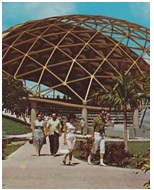 Page 166. The Seaquarium opened in 1955. In 1967 it would have been about a tenth of its present size. At left is the ‘golden dome’, circa 1967.
Page 166. The Seaquarium opened in 1955. In 1967 it would have been about a tenth of its present size. At left is the ‘golden dome’, circa 1967.
Page 184. During the 1960s, the Dupont Plaza was the closest thing to a ‘luxury’ hotel in downtown Miami. Located at the mouth of the Miami River, it was torn down in 2004.
Page 189. You Only Live Twice premiered June 12, 1967.
Page 194. American-born Philip Staros (1918-1979) was a member of the Rosenberg spy ring who fled to Mexico in 1950 following the arrest of Julius and Ethel Rosenberg and then to the Soviet Union. In the 1960s he became the USSR’s chief proponent of semiconductor technology.
Page 196. Robert Noyce and Gordon Moore would go on to form Intel in 1968. Eugene Kleiner was the driving force behind Kleiner Perkins Caufield & Byers, perhaps the most successful venture capital firm in history.
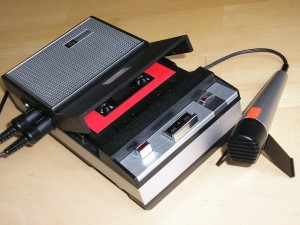 Page 203. Compact cassette recorders were introduced in 1964. At right is a 1967 unit from Philips.
Page 203. Compact cassette recorders were introduced in 1964. At right is a 1967 unit from Philips.
Page 214. Today, we would say that Grodny is in Belarus. Lansky’s parents were Polish. At the beginning of the twentieth century it was all part of the virulently anti-semitic Russian Empire. Lansky’s family fled for America in 1911. In 1914, Russian forces killed or expelled more than half the region’s Jewish population.
Pages 239 – 240. Everything on those two pages is factual. You decide if any of it is linked.
Finally: Below is an ad from a November 1967 issue of Time magazine. This is part of the reason Susan Delaney loved her job. Even if you were called ‘gal’ and it took three years before you made $6600 a year, you had what was undeniably one of the most glamorous jobs in the world.
Pan Am’s Flight Attendant Academy was three blocks from my home. It was a stunning building, reportedly modeled on the U.S. Embassy in India. The women who spent six-month stints there were beautiful and poised (and very much out of my league).